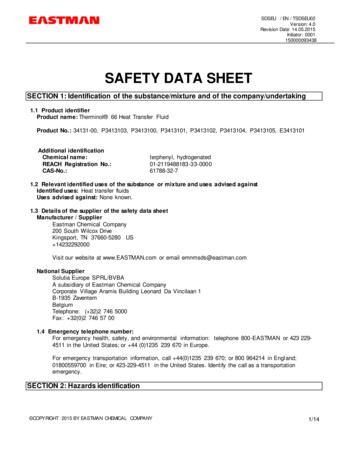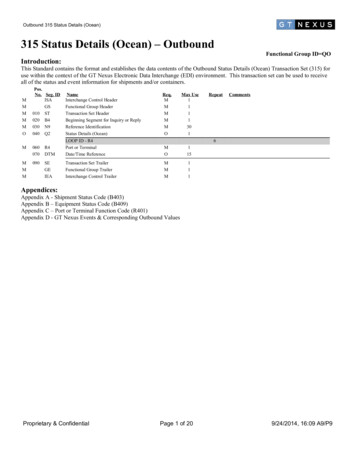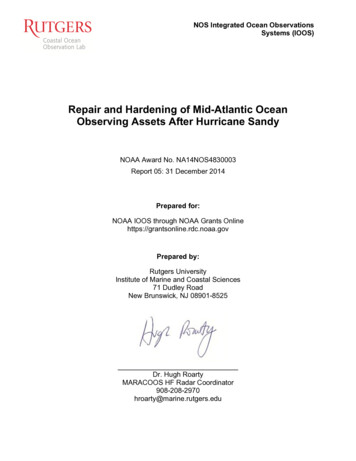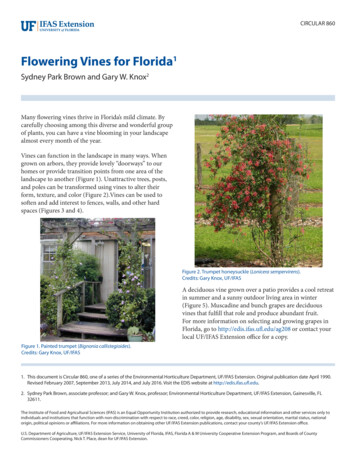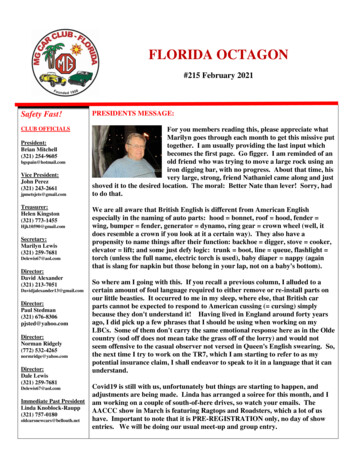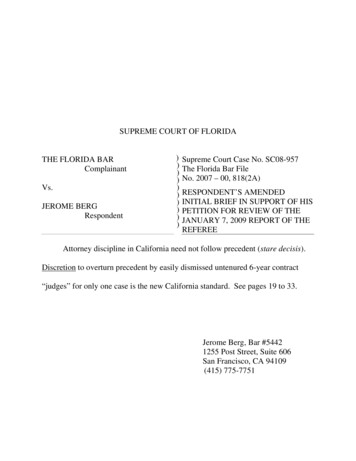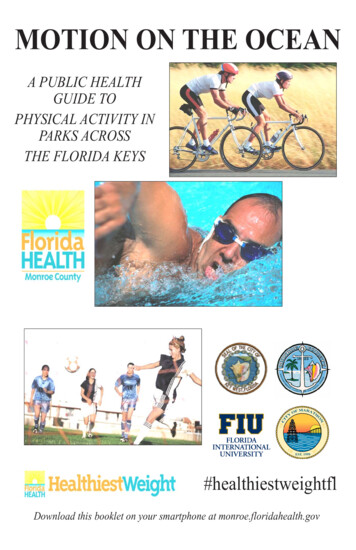
Transcription
MOTION ON THE OCEANA PUBLIC HEALTHGUIDE TOPHYSICAL ACTIVITY INPARKS ACROSSTHE FLORIDA KEYS#healthiestweightflDownload this booklet on your smartphone at monroe.floridahealth.gov
2
Editorial Board: Executive Lead Team,Florida Department of Health in Monroe CountyBob Eadie, AdministratorMark Whiteside MD MPH, Medical DirectorMary Vanden Brook, Administrative Services DirectorBill Brookman MPH, Community Health Services DirectorJoan Higgs RN, Nursing DirectorMary Turner, ARNP, Nursing DirectorDr. Joseph Yates Porter(1847-1927)Map CreditsDr. Derrick Scott and Armando LuzulaDepartment of Global and Socio-Cultural StudiesFlorida International UniversityKey West Native andDirector of Florida’s First State Board of HealthResearchersAlison Morales Kerr, MPH, Community Health Program Manager, DOH-MonroeChristopher Tittel, MA, Marketing Director, DOH-MonroeMark Whiteside, MD, MPH, Medical Director, DOH-MonroeAndrew Bulla, MBA, MS, Administrative Services, DOH-MonroeCourtney Smith, RD, LD, DOH-MonroeRyan Porterfield, Bachelor of Science in Biotechnology Candidate, University of FloridaKevin Wilson,P.E., Division Director, Public Works & Engineering, Monroe CountyRoman Gastesi, Administrator, Monroe CountyDebbie Frederick, CPM, Deputy Administrator, Monroe CountyVirginia Burgohy Irving, Ed.D., Douglass School Black Educators’ Memorial Project, Inc.Photo CreditsEric WhitesideAmy GrimmChristopher TittelDanielle CarsonDesignerChristopher Tittel3
FROM THE ADMINISTRATORWelcome to Motion on the Ocean, a guide to parks across the Florida Keys that has been written,photographed, and designed with fitness in mind.In 2013, Dr. John H. Armstrong, State Surgeon General and Secretary of Health, initiated theHealthiest Weight Florida campaign. With an obesity epidemic nationwide, Dr. Armstrong hasinstructed the Florida Department of Health and its subsidiaries in each of Florida’s 67 counties totake the lead on promoting routine exercise and proper diet as the keys for Floridians to establish andmaintain the healthiest weights in the nation.Monroe County boasts some of the most pristine parks in the state, offering locals and visitorsendless opportunities to engage in calorie-burning activities on both land and sea.Our partners at the state, county, and municipallevels do their best to ensure that these parks areeasy to access, clean, and safe. In many cases,playing surfaces — basketball and tennis courts,skateboard ramps, soccer fields, etc. — have beenpaved and manicured to ensure the best playingsurfaces possible.As you leaf through this unique public healthdirectory, I encourage you to shape a fitnessroutine that takes you to one or more of the morethan 65 state, county, and municipal parksprofiled here. Start by getting a rough idea of Bob Eadie, administrator at the Florida Department of Health in MonroeCounty, right, joins teammates Deb Chesnet and Andrew Bulla at theyour body mass index, the measurement that finish line of Triathlon Key West in 2010.many public health professionals use to plot aperson’s progress when it comes to weight loss (page 7). Once you’ve calculated your BMI, checkthe chart to see your weight status in comparison with others. Consult your doctor on the best courseof action, especially if you are obese, overweight, or underweight. Plan your fitness regimen: Perusethe physical activity table to see how much you can burn doing even the most basic activities for justan hour (page 8). Whether you’re a fitness enthusiast or just a beginner, you’ll find an activity andpace that works for you.Locate the park(s) listed in this directory that are nearest to you, where you can engage in yourchosen activity (parks listing starts on page 15). Log your activities and approximate calories burnedusing Your Fitness Counter (page 9).If you stick with your fitness program and eat healthy — ideally, you want to burn more caloriesthan you consume — you should notice a change in your BMI after a few weeks.Consider finding a partner, or group of partners, to join you in this effort. Make it a family affair.Employers might host a day out at a park, where employees can have fun while getting fit.For anyone who’d like to learn more about all of the parks in the Florida Keys, challenge yourself toengage in a fitness activity every day, every other day, or every week, at a different park.Best of luck!4Bob Eadie
FROM THE MEDICAL DIRECTORParks and preserves are essential not only to maintaining living systems andbiodiversity, but also to promoting good health and well-being among the public.Parks are used for organized sports and fitness, public meetings andentertainment, water activities, education, and environmental activities. They alsoprovide a place for people (and their pets) to simply wander around and enjoy thenatural scene. As you will see in this directory, the Florida Keys have a multitiered system of parks and wildlife refuges administered through city, county,state, and federal authorities.Physical Activity and Exercise. “Physical activity” is defined as anythingthat gets you moving (e.g., walking the dog); “exercise” is a more planned andstructured form of physical activity. Regular physical activity and exercise is, quitesimply, the most important thing we can do for our health.Case in point: Children reportedly spend more than 6 hours a day in front ofcomputer and television screens, compared to 30 minutes a day in outdoor physicalactivity. This very well could be a major contributing factor to the nationwidechildhood obesity epidemic that we’ve been hearing so much about in the news.Both children and adults need to get outside and get moving, and our parks andgreen spaces are a good place to begin.Also, see your doctor before you start an exercise program, especially if you havea chronic illness and/or have not exercised in a while.Natural Connection. Connecting to the natural world not only helps reducethe stress that high-tech, fast-paced societies can bring, but also has a restorativeeffect and brings balance to our lives. Mobile EEGs (brain wave tracings) revealthat when we enter a natural setting, our minds enter a state resembling meditation.Potential health benefits of direct contact with nature include: reduced stress, lowerblood pressure, increased mental clarity, and a more positive outlook on life.People can tune into the “natural rhythms of the earth” in our green areas, as well.The earth’s cavity produces a specific pulsation (the Schumann resonance) that actsas a master “tuning fork” and closely matches our alpha brain waves. Theseelectromagnetic forces work in tandem with geomagnetic waves coming frombelow the earth’s surface. The earth’s low-frequency pulses are often drowned outby the stronger manmade EMFs (electromagnetic fields) in cities. Man was notdesigned to live among these all-pervasive EMF signals. Electro-pollution isarguably the most neglected public health problem and probably contributes tocertain cancers like leukemia and also early dementia (Alzheimer’s). Parks help usrecharge our batteries and provide temporary refuge from the EMF noise of the city.Parks and preserves with the best “restorative qualities” have safe natural areasthat give the flavor of “being away” (from your usual environment), encouragefascination with nature, foster the sense of being a part of a larger whole, and offer avariety of activities that satisfy the needs of the user population. Bird- and butterfly-watching are two activities that can help us reconnect with nature.5Benefits of PhysicalActivity andExercise Maintain a healthy weightLower bloodpressureIncrease HDL(“good”cholesterol)Improve moodBoost energyEasier sleep andrestLower chances ofcertain cancersImprove staminaStrengthen/tonemusclesEnhance flexibilityReduce stressHelp prevent fallsExercising 30-60minutes per day canreduce the chancesof prematuredisability or death by40 percent!Dr. Mark Whiteside
TABLE OF CONTENTSHealthiest Weight Florida & BMI7Marathon Community Park and Skate Park21Physical Activity Table8Parks Map (Lower Keys)22Your Fitness Counter9Veterans Memorial Park23Special Section: Birding in the Florida Keys10Bahia Honda State ParkSpecial Section: Butterflying in the Florida Keys 11Big Pine Key Community ParkGeneral Park Notes & Health Tips13Palm Villa ParkParks Map (Upper Keys)14Watson Field and Big Pine Dog ParkDagney Johnson Botanical State Park15Blue Heron Leisure ClubFlorida Keys Overseas Heritage TrailRamrod ParkMurray Nelson Gov Ctr Community ParkSugarloaf SchoolJohn Pennekamp Coral Reef State ParkBay Point ParkFriendship ParkWilhelmina Harvey ParkKey Largo Community Park/Pool16Boca Chica BeachHarry Harris Beach/ParkParks Map (Key West)Bernstein Park17San Pedro Underwater Archeol. Preserve ParkSmathers Beach28Rosa Hernandez Softball FieldIslamorada Library Beach ParkWickers Sports ComplexIndian Key Historic State ParkCozumel ParkLignumvitae Key Botanical State Park29Little Hamaca ParkAnne's BeachParks Map (Middle Keys)18Long Key State Park19Sunset Bay ParkFran Ford White-Crowned Pigeon PreserveBayview Park30Rest Beach/C.B. Harvey ParkHiggs Beach/Dog ParkCurry Hammock State ParkAstro Park PlaygroundCoco Plum BeachSonny McCoy Indigenous ParkEast Side Park31City of KW Nature PreservesSunset Park BeachSimonton Street BeachKey Colony Beach Children's Playground20Key Colony Beach Walking & Jogging PathsBill Butler ParkFort Zachary Taylor Beach/Park32Fredrick Douglass GymOceanfront ParkMartin Luther King Rec CenterRotary Children's ParkSombrero BeachKey West Pines Park (KW Airport)Clayton Sterling ComplexWindley Key Fossil Reef Geological State ParkKey Colony Beach Golf & Tennis2627FKCC Swimming PoolFounders ParkBurr Beach/Park25Big Coppitt Volunteer Fire Department ParkSunset Point ParkOld Settler's Park242133Special Feature: Dry Tortugas, National Park 34Jesse Hobbs Park6
www.healthiestweightflorida.com / #healthiestweightflAs of 2014, only 36 percent of Floridians were ata healthy weight. On our current trend, by 2030,almost 60 percent will be obese. Additionally, sixout of ten children born today willbe obese by the time they graduatehigh school.Over the next 20 years in Florida,obesity is expected to contribute tomillions of cases of preventablechronic diseases such as type 2diabetes, heart disease, and cancer,costing an estimated 34 billion. ToDr. John H.addressthis important public healthArmstrong,state surgeon issue, the Department of Healthgeneral and launched the Healthiest Weightsecretary ofFlorida initiative in January 2013.health,Healthiest Weight Florida offersinitiatedHealthiestfive strategies to maintaining aWeighthealthy weight. This guide wasFlorida indeveloped with the first strategy in2013.mind: increasing opportunities forphysical activity. The other fourstrategies include: making healthyfood available everywhere,promoting health in the worksite,strengthening schools as the heart ofhealth, and marketing what mattersfor a healthy life.Being physically active can help:Control weightReduce the risk of cardiovascular diseaseReduce the risk of type 2 diabetesReduce the risk of some cancersStrengthen bones and musclesImprove mental health and moodImprove ability to do daily activities andprevent falls in older adults Increase the chances of living longerHow Do I Calculate My BMI?Body mass index (BMI) is an estimation of body fat basedon height and weight. BMI is a way to see if you are in ahealthy range.The correlation between the BMI number and body fatnessis fairly strong; however, the correlation varies by sex, raceand age.It’s always best to see your doctor to determine your BMIand get advice on the best fitness plan for you.To get a rough idea of your BMI, the Centers for DiseaseControl and Prevention recommends that you divide yourweight in pounds by your height in inches squared andmultiply by 703.For example, if you weigh 150 pounds and stand 65 inchestall (5’5”), your BMI is 24.96. You would be consideredborderline normal/overweight, in terms of the standardweight status categories associated with BMI ranges foradults.Weight: 150 poundsHeight in inches squared:65 x 65 4,225150 / 4,225 .035.035X 70324.96 7BMIWeight StatusBelow 0.0 and AboveObese
Physical Activity TableExercise and physical activity fall into four basiccategories: endurance, strength, balance, andflexibility. Most people tend to focus on one activity ortype of exercise and think they’re doing enough. Eachtype is different. Doing them all will give you morebenefits. Mixing it up also helps to reduce boredomand cut your risk of injury.EnduranceEndurance, or aerobic, activities increase yourbreathing and heart rate. Some examples: Brisk walking or jogging Swimming Biking Playing tennis or basketballStrengthStrength exercises make your muscles stronger. Someexamples: Isometrics Weight lifting Pilates.BalanceBalance exercises help prevent falls, a commonproblem in older adults. Many lower-body strengthexercises also will improve your balance. Someexamples: Standing on one foot Heel-to-toe walk Tai Chi YogaFlexibilityFlexibility exercises stretch your muscles and canhelp your body stay limber. Some examples: Shoulder and upper arm stretch Calf stretch YogaThe table to the right lists simple activities that youcan engage in at any of the parks profiled in this guide.Figures on calories burned per hour for four differentweights are provided for each activity.Establish a fitness routine that includes exercises forendurance, strength, balance, and flexibility.Make sure that the number of calories you are burningthrough fitness is greater than the number of caloriesyou’re consuming as part of a balanced 6326236281327372Football or Baseball(playing catch)148176204233Frisbee177211245279Golf (walking, carrying hooting baskets)Calisthenics (light,pushups, sit-ups, etc.)Cycling(leisure, 10 mph)Kickball413493572651Mild Stretching148176204233Roller Blading7088449811,117Running (5 mph, 12-minute mile)472563654745Scuba eling295352409465Soccer (game)413493572651Softball or Baseball(game)295352409465236281327372Swimming (treadingwater, moderate)236281327372Tai chi236281327372Tennis 2409465Walking (5 mph)472563654745Water Aerobics236281327372Stretching(hatha yoga)Walking(2 mph, slow)Walking(3.5 mph, brisk)Walking(4 mph, very brisk)Sources: National Institutes of Health andNutriStrategy. For figures on additional fitness activities,visit www.nutristrategy.com/activitylist4.htm .
DateLocationActivity(see page 8)Calories Burnedper Hour XXXXXXXXXXXXXX Time SpentXXApproximateNumber ofCalories BurnedYour Fitness Counter9
Special Section: Birding in the Florida KeysAntillean nighthawkBirding (aka, “bird watching”) is an exciting, healthy hobbyguaranteed to get you off the couch and outdoors into the fresh air.Birding is a great way to get exercise and tune in to nature. It can bedone anytime and anywhere; Birding is associated with travel,photography, gardening, hiking, and conservation. Parks, preserves,and shorelines across the Florida Keys are special places for birds.Black-whiskered vireoJohn James Audubon, the world-renowned naturalist and natureartist who discovered more than 50 newly described species of birdsin Florida, arrived in the Keys in 1832. He wrote his wife thatbirdlife was so abundant in the Keys that “the air was darkened withwhistling wings.” This famous artist would excite much of the worldwith his life-like portraits of birds. The National Audubon Societywas founded in later years in response to plume hunters slaughteringbeautiful wading birds for their feathers. The founding put the nationon a new course of wildlife conservation.Today, more than 50 million people in the United States considerthemselves birders. Serious birding started in the northeastern UnitedStates and was popularized with the field guides of Roger ToryPeterson. The sport took off after World War II with thedevelopment of good quality binoculars, increased leisure time, anda growing appreciation of the natural environment. It remains one ofthe fastest growing outdoor hobbies today (after gardening).The chain of islands we call the Florida Keys is really an extension Great white heronof the West Indies (some describe them as “the Caribbean Islandsthat you can drive to.”) Many of the breeding birds of the Keys arerepresentative of Caribbean species, found here and nowhere elseoutside of South Florida. Despite human development, the Keyspreserve three predominate upland habitats: West Indian hardwoodhammock, pine rocklands, and mangrove forest.Specialty breeding birds of the Florida Keys include: the whitemorph of the great blue heron (“great white heron”), reddish egret,Reddish egretwhite-crowned pigeon, mangrove cuckoo, Antillean nighthawk, graykingbird, black-whiskered vireo, and Cuban yellow warbler. Thepossibility of Caribbean strays or “vagrants” sighted in the FloridaKeys adds to the excitement, with about 20 species recorded over theyears, including the North American first loggerhead kingbird in2007, and a recent Key West quail dove.The Dry Tortugas, a small group of islands located 70 miles westof Key West, is one of the top birding destinations in North America.It is well known for its breeding colonies of masked boobies, sootyand noddy terns. These federally protected islands are a “migrantWhite-crowned pigeontrap” in the spring and fall when (depending on weather conditions)10
birds may literally be hopping around at your feet. Many ocean-going (or “pelagic”) birds can be seen duringthe 3-hour boat trip from Key West.Birding is good in the Keys year-round: Breeding birds are found in the spring and summer, with the peak ofmigrating songbirds in April and September. Hawks filter through the Keys in October. There is an annual fallraptor count at Curry Hammock State Park in the Middle Keys, known as one of the best sites for viewingmigrating hawks in North America. Often, more than 1,000 individuals of a dozen species of raptor arecounted. Many eastern birds winter in the Keys, and the Audubon Christmas bird count may tally 100 species.There are dozens of good birding spots in the Florida Keys, from Dagny Johnson Key Largo HammockBotanical State Park in north Key Largo to McCoy Indigenous Park and Fort Zachary Taylor State Park inKey West. Many of these spots are featured on the Great Florida Birding and Wildlife Trail. The Florida KeysBirding and Wildlife Festival is held every year (fall season) in the Middle Keys and includes a wide varietyof events, field trips, and even a hawk watch.To get started in birding, all you need is a good pair of binoculars, a field guide to the birds in your area, anda notebook. Begin to look up! If you list the birds you already recognize in your neighborhood, you’ll be onyour way. It always helps to learn from others, and you’ll get plenty of help if you just ask for it. You canalways join your local bird club or Audubon Society (e.g., Florida Keys Audubon Society atwww.keysaudubon.org) and sign up for a field trip. Birding can open up a whole new world for you.References: The best field guides to birds include: The Peterson Field Guide to Eastern Birds (Roger Tory Peterson, HoughtonMifflin Company, Boston/New York, 1980), The Sibley Guide to Birds (David Allen Sibley, National Audubon Society, AlfredKnopf, 2000) and the National Geographic Field Guide to the Birds of North America (John Dunn and Jonathon Alderfer, 6thEdition). The best reference for bird finding in Florida, with a special section on the Florida Keys, is The ABA/Lane BirdfindingGuide, A Birder’s Guide to Florida (Bill Pranty, American Birding Association, 2005). Finally, Miami’s Tropical AudubonBirdboard p
Welcome to Motion on the Ocean, a guide to parks across the Florida Keys that has been written, photographed, and designed with fitness in mind. In 2013, Dr. John H. Armstrong, Sta


